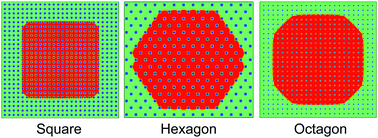A numerical study of droplet dynamic behaviors on a micro-structured surface using a three dimensional color-gradient lattice Boltzmann model
Abstract
Inspired by the experimental work of Raj et al. (high-resolution liquid patterns via three-dimensional droplet shape control), in the present study, a three-dimensional multiphase color-gradient lattice Boltzmann model developed previously by some of the authors is used to simulate droplet dynamic behaviors with different surface micro-pillar arrays. To facilitate the present simulation, wetting boundary conditions are used and the accuracy of color gradient prediction at boundary nodes is enhanced. The experimental findings are confirmed and non-circular contact lines are reproduced numerically for the first time. To justify the existing contact angle formula proposed based on the Wenzel model, a systematic parametric study is conducted, based on which the pillar density is redefined to allow for the influence of pillar height, and then it is used to modify the contact angle. In addition, the evolution of the contact line motion for various droplet shapes is investigated systematically, and both circular and non-circular contact characteristics are well-depicted for different surface micro-pillar arrays.



 Please wait while we load your content...
Please wait while we load your content...